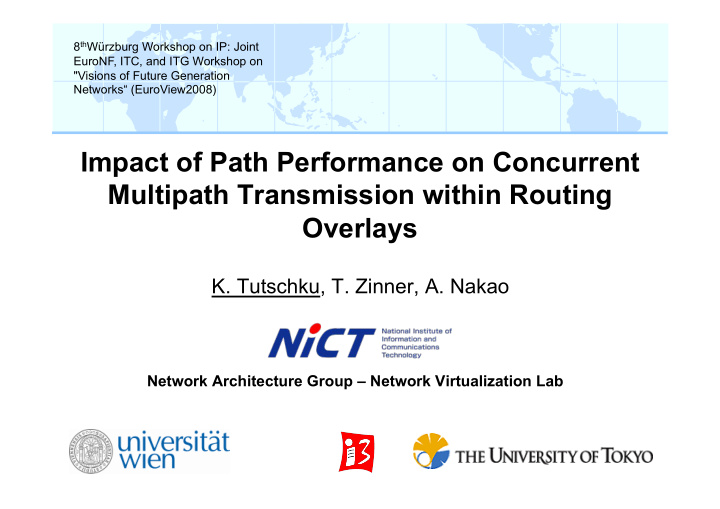



8 th Würzburg Workshop on IP: Joint EuroNF, ITC, and ITG Workshop on "Visions of Future Generation Networks“ (EuroView2008) Impact of Path Performance on Concurrent Multipath Transmission within Routing Overlays K. Tutschku, T. Zinner, A. Nakao Network Architecture Group – Network Virtualization Lab
Future Internet? How to approach? Clean slate approach? UC Berkey, Intel: Declarative Networking ; Parc (V. Jacobson) : Content Centric Networking Evolutionary approach? IRTF RRG/ ALTO BOF: Location / Identifier Split, (ISP-Supported) Path Selection Service iPhone 3G start: 3G already commodity but Apple’s App Store dominates blogs FI should please applications
What Features are Currently Missing? End-to-end QoS, but: QoS-Islands are available (depending on technology and provider) Application layer mechanisms are highly efficient (Skype, P2P CDNs) Reliability, but: Sophisticated TE and Resilience concepts available at experienced ISPs Competition/Business models, but : J. Crowcroft: “… i can go on the web and get my gas, electricity, … changed , why is it not possible to get a SPOT price for broadband internet? ” (E2E-interest mailing list on April 26 th , 2008) Why is it so complex to include such features in the Internet?
Capabilities and Features of the Current Internet: A (Special Thanks to Michael Menth for visualization support) B C D(A,C) ≤ D(A,B) + D(B,C) Triangle Inequality (TI) PoP-level Path Diversity Use neighbors that minimize delay! Easy in an Euclidean space R. Teixera et al. (2003): 50% of PoPs have more than 3 links to other PoPs PlanetLab measurements (S. Banerjee et al., 2004): 25% of TI Multiple routes readily available! violations Better routes exist Apply routing overlays for integration and push application layer mechanisms to routing layer
SORA: Scalable Overlay Routing Architecture 1 Divert selected endhost packets 3 Encapsulated, send using path Decapsulate, egress to destination 2 Request Paths for Diverted Packets 4 One-hop source routing Gummadi et al (2004): Increased reliability while being scalable Nakao, Lane (2007): Multi-path aware application to resource mgmt C-D separation implemented (path computation and forwarding) Pushing End-to-End Principle to Routing ᴉ May be inefficient Reduction of overhead (since edge-based)
Network Virtualization: Capabilities Computational Virtualization Manager Apps apps Apps Apps MngOS GuestOS GuestOS GuestOS GuestOS Use Computer Center as a PC with VM VM VM Apps VM VM user-specific environment VMM HostOS Hardware Hardware Hypervisor-based Host-based Fully Virtualized Networks EuroView architecture Use network with user-specific (a first concept, UniWürzburg) mechanisms (routing/resource access) Decision (e.g. by application) Network-view Application Direct control Network-virtualization capable Dissemination router everywhere Mediation Resource isolation (I/O virtualization) Discovery and resource independence (resource Connectivity can be located every where) Data Virtual topology and virtual resource management Adapted from A. Greenberg, J. Rexford et al. (2005)
Virtual Resource Management: Concurrent Multipath Transfer in Multihomed Overlays (Striping) overall transport Individual Overlay paths pipe Physical topologies of different Different overlays providers Features: (First) aim: Obtain high throughput Increased reliability and very high conceal triangle inequality violations Solution: capacity Combine multiple paths (provided by disjoint overlays) into an overall transport pipe Interdomain traffic management and exploit high access bandwidth edge-based performance control avoid congested areas discover available bandwidth in core
Transmission Model each provider will offer a set n i of parallel paths Data stream divided at router into p 1,1 (i = 1…m) segments with k parts overlay 1 p 1,n1 1 Assump7on: use k parallel paths on m 2 overlays 1 k parts have src k paths dst arrived k k‐1 k p m,1 k parts are send in overlay m parallel at 7me t p m,nm Re-ordering? With paths
Performance Evaluation First analysis by Y. Nebat and M Sidi (2006) Two synchronous, equal capacity paths (= sources) Maximal packet delay d max = 300msec ; Uniformly delay Normal distributed delay: µ = 150msec; σ low = 50 msec and ; σ high = 75 msec Buffer Delay norm: σ low norm: σ low / σ low norm: σ high / σ high norm: σ high uniform / P(K) P(d) norm: σ low uniform / uniform uniform Packet delay d [msec] Resequencing buffer occupancy K
Conclusion Relationship to P2P content distribution: View each path as a peer Select paths/peers such that reordering/throughput/resilience is minimized/optimized Network Virtualization Enables multiple, parallel application-specific routing overlays (specific i.e. wrt. routing/topology/resource management ) Future work: Identify timescale for overlay setup / adaptivity Extend analytical performance model to N paths with hetero- geneous capacity (Paper available in September 2008 from NICT, University of Wuerzburg, and University of Vienna)
Recommend
More recommend